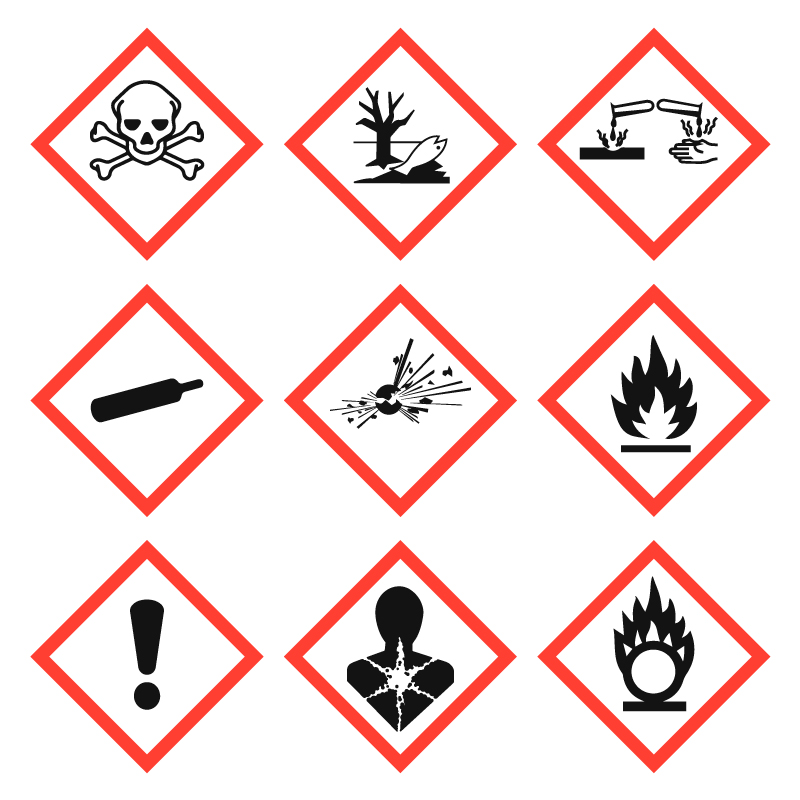New Hazard Symbols from the GHS
04/05/2016
In 2015 new European regulations have been working on New Hazard Symbols from the GHS and phasing out the symbols you and I are familiar with and have begun replacing these symbols with a new harmonised classification for world wide use the New Hazard Symbols from the GHS. This is all part of a system named the Globally Harmonized System of Classification and Labelling of Chemicals. The system was cooked up by the U.N. in '92 and aims to make all symbols on hazardous substances and materials packaging conform to a globally agreed criteria.
the United Nations Economic Commission for Europe (UNECE) quote:
"Given the reality of the extensive global trade in chemicals and the need to develop national programs to ensure their safe use, transport, and disposal, it was recognized that an internationally harmonized approach to classification and labelling was needed."
"once countries have consistent and appropriate information on the chemicals they import or produce in their own countries, the infrastructure to control chemical exposures and protect people, and the environment can be established in a comprehensive manner."
The New Hazard Symbols from the GHS must be learned by those working within industry

A CLP training course will provide a good understanding of the new Classification Labelling Packaging (CLP) Regulations.
Chemicals, through the different steps from their production to their handling, transport and use, are a real danger for human health and the environment. People of any ages, from children to elderly, using many different languages and alphabets, belonging to various social conditions, including illiterates, are daily confronted to dangerous products (chemicals, pesticides, etc.)
To face this danger, and given the reality of the extensive global trade in chemicals and the need to develop national programs to ensure their safe use, transport and disposal, it was recognized that an internationally-harmonized approach to classification and labelling would provide the foundation for such programs. Once countries have consistent and appropriate information on the chemicals they import or produce in their own countries, the infrastructure to control chemical exposures and protect people and the environment can be established in a comprehensive manner.
The new system, which was called "Globally Harmonized System of Classification and Labelling of Chemicals (GHS)", addresses classification of chemicals by types of hazard and proposes harmonized hazard communication elements, including labels and safety data sheets. It aims at ensuring that information on physical hazards and toxicity from chemicals be available in order to enhance the protection of human health and the environment during the handling, transport and use of these chemicals. The GHS also provides a basis for harmonization of rules and regulations on chemicals at national, regional and worldwide level, an important factor also for trade facilitation.
While governments, regional institutions and international organizations are the primary audiences for the GHS, it also contains sufficient context and guidance for those in industry who will ultimately be implementing the requirements which have been adopted.
The first edition of the GHS, which was intended to serve as the initial basis for the global implementation of the system, was adopted in December 2002 and published in 2003.
Since then, the GHS has been updated, revised and improved every two years as needs arise and experience is gained in its implementation:
GHS Rev.1 (2005):
includes, inter alia, various revised provisions concerning classification and labelling, new provisions for aspiration hazards and new guidance on the use of precautionary statements and pictograms and on the preparation of safety data sheets.
GHS Rev.2 (2007):
includes, inter alia, new and revised provisions concerning the classification and labelling of explosives; respiratory and skin sensitizers; toxic by inhalation gases and gas mixtures; additional guidance on the interpretation of the building block approach and on the evaluation of the carcinogenic potential of chemicals; and the codification of hazard and precautionary statements.
GHS Rev.3 (2009):
includes, inter alia, new provisions for the allocation of hazard statements and for the labelling of small packaging; two new sub-categories for respiratory and skin sensitization; the revision of the classification criteria for long-term hazards (chronic toxicity) to the aquatic environment; and a new hazard class for substances and mixtures hazardous to the ozone layer.
GHS Rev.4 (2011):
includes, inter alia, new hazard categories for chemically unstable gases and non-flammable aerosols; further rationalization of precautionary statements and further clarification of some of the criteria to avoid differences in their interpretation.
GHS Rev.5 (2013):
includes, inter alia, a new test method for oxidizing solids, miscellaneous provisions intended to further clarify the criteria for some hazard classes (skin corrosion/irritation, severe eye damage/irritation, and aerosols) and to complement the information to be included in the Safety Data Sheet; revised and simplified classification and labelling summary tables; a new codification system for hazard pictograms, and revised and further rationalized precautionary statements.
GHS Rev.6 (2015):
includes, inter alia, a new hazard class for desensitized explosives and a new hazard category for pyrophoric gases; miscellaneous provisions intended to clarify the criteria for some hazard classes (explosives, specific target organ toxicity following single exposure, aspiration hazard and hazardous to the aquatic environment); additional information to be included in the Safety Data Sheets (section 9); revised and further rationalized precautionary statements and a new example in Annex 7 addressing labelling of small packaging.
Information sourced from: http://www.unece.org/trans/danger/publi/ghs/ghs_welcome_e.html
Classification Labelling Packaging (CLP) Training
- Work towards compliance with UK Health and Safety legislation
- Accredited by CPD
- Instant certificate
